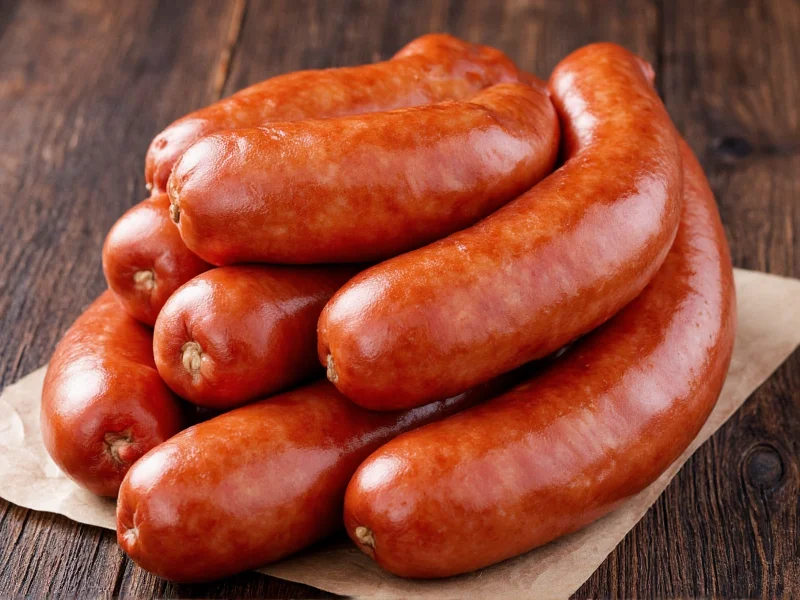When preparing big sausages, understanding their unique characteristics is essential for achieving perfect results. Unlike their smaller counterparts, these substantial meat links present specific challenges that require adjusted cooking methods and timing. The increased diameter means heat penetration takes longer, creating a higher risk of either undercooked centers or charred exteriors if standard sausage cooking techniques are applied.
Understanding Big Sausage Varieties
Big sausages span numerous culinary traditions worldwide, each with distinctive ingredients, seasonings, and preparation methods. German bratwurst, typically made from pork or veal with fresh herbs, ranges from 1.5 to 2 inches in diameter. Polish kielbasa features a coarser grind and smoked flavor, while andouille from Louisiana cuisine contains distinctive Cajun spices and often measures over 1.75 inches across.
British "bangers" earned their name during World War II due to the high water content causing them to pop when cooked. South African boerewors forms a continuous spiral rather than individual links and can reach impressive diameters of 2 inches or more. Italian luganega, a long, coiled pork sausage, and Spanish morcilla (blood sausage) also qualify as big sausages in their traditional preparations.
| Sausage Type | Typical Diameter | Primary Ingredients | Cooking Method |
|---|---|---|---|
| Bratwurst | 1.5-2 inches | Pork, veal, fresh herbs | Parboil then grill |
| Kielbasa | 1.75 inches | Smoked pork, garlic | Grill or pan-fry |
| Andouille | 1.75-2 inches | Pork, Cajun spices | Smoke then simmer |
| Boerewors | 2+ inches | Beef, lamb, spices | Grill over indirect heat |
Specialized Cooking Techniques for Big Sausages
Cooking big sausages properly requires understanding heat transfer principles for thicker meat products. The standard approach of direct grilling often results in burnt exteriors with raw centers. Instead, professional chefs recommend a two-stage cooking process: initial gentle heating to bring the internal temperature up, followed by a shorter period of higher heat to develop flavor and texture.
Parboiling big sausages in simmering water or beer for 10-15 minutes before finishing on the grill allows the interior to reach a safe temperature without overcooking the casing. Alternatively, oven-roasting at 325°F until the internal temperature reaches 140°F, then finishing on a hot grill for 2-3 minutes creates perfectly cooked results. For those using charcoal grills, the indirect heat method—placing sausages away from direct flames—provides more controlled cooking.
Avoiding Common Big Sausage Cooking Mistakes
Many home cooks make critical errors when preparing big sausages that compromise both safety and quality. Poking holes to check doneness allows precious juices to escape, resulting in dry, less flavorful meat. Cutting into sausages to check temperature creates the same problem while also increasing contamination risk.
The ideal method for checking big sausage doneness involves using an instant-read thermometer inserted sideways through the end. Properly cooked pork sausages should reach 160°F internally, while poultry-based big sausages require 165°F. Allowing sausages to rest for 5-7 minutes after cooking lets juices redistribute, ensuring moist results when sliced.
Flavor Pairings and Serving Suggestions
Big sausages pair exceptionally well with complementary flavors that balance their richness. Traditional German combinations include sauerkraut and mustard with bratwurst, while Polish kielbasa shines with caramelized onions and rye bread. Andouille sausage enhances gumbo and jambalaya with its smoky depth, and boerewors traditionally accompanies tomato and onion relish.
For modern presentations, consider slicing cooked big sausages diagonally to expose more surface area for sauces and garnishes. Serving with acidic components like pickled vegetables or citrus-based sauces cuts through the richness, while hearty starches like potato salad or crusty bread provide satisfying contrast. When planning big sausage recipes for family meals, remember that their substantial size makes them ideal for slicing and incorporating into pasta dishes, stews, or breakfast hash.
Storage and Handling Considerations
Proper storage of big sausages differs slightly from standard varieties due to their greater mass. Fresh big sausages should be refrigerated below 40°F and used within 1-2 days of purchase. When freezing, wrap individual sausages tightly in freezer paper before placing in airtight containers to prevent freezer burn, which affects thicker sausages more noticeably.
Thaw frozen big sausages in the refrigerator rather than at room temperature to maintain food safety. The increased mass means they require 24-48 hours to thaw completely, so planning ahead is essential. Never refreeze previously frozen big sausages unless they've been fully cooked first, as the texture deterioration becomes particularly noticeable in larger diameter products.
What's the ideal internal temperature for cooked big sausages?
Pork-based big sausages should reach 160°F internally, while poultry-based varieties require 165°F. Use an instant-read thermometer inserted sideways through the end for accurate measurement without losing juices.
How can I prevent big sausages from splitting during cooking?
Prevent splitting by starting big sausages in cool water and gradually bringing to a simmer, or by pricking the casing in several places with a needle (not a fork) before cooking. Avoid high heat during initial cooking stages.
Why do big sausages require different cooking times than regular sausages?
The increased diameter creates a greater distance for heat to travel to the center. Standard cooking times would result in burnt exteriors before the interior reaches safe temperatures, necessitating adjusted methods like parboiling or indirect grilling.
Can I cook big sausages in the oven instead of grilling?
Yes, oven cooking works well for big sausages. Bake at 325°F until internal temperature reaches 140°F (about 25-35 minutes depending on size), then finish under the broiler for 2-3 minutes to develop browning and texture.
How long do cooked big sausages last in the refrigerator?
Properly stored in an airtight container, cooked big sausages remain safe to eat for 3-4 days in the refrigerator. Reheat thoroughly to 165°F before serving leftovers.











 浙公网安备
33010002000092号
浙公网安备
33010002000092号 浙B2-20120091-4
浙B2-20120091-4